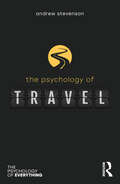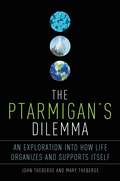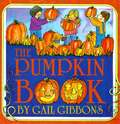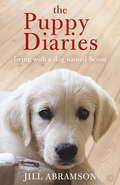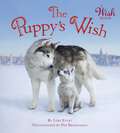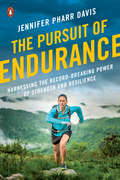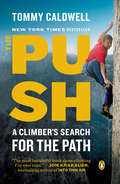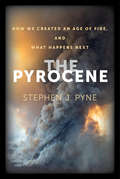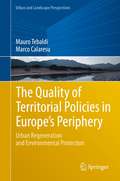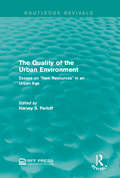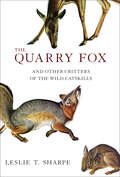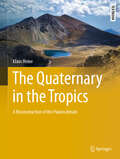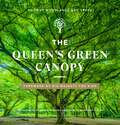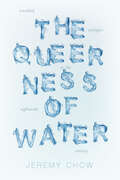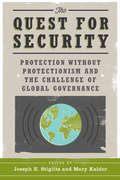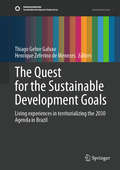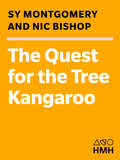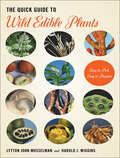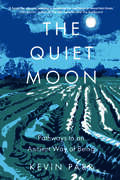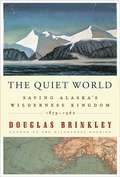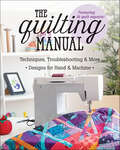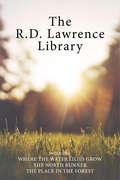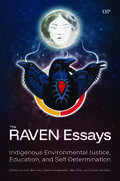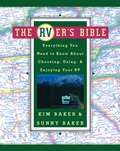- Table View
- List View
The Psychology of Travel (The Psychology of Everything)
by Andrew StevensonWhy do we travel? Are holidays good for our health? What are the social and psychological factors that drive us to move? The Psychology of Travel provides an eclectic introduction to the range of travel experiences from commuting, to going on holiday, to studying abroad. Travel is a near-universal experience and manifests itself in various forms, from everyday experiences to exotic adventure, although it varies across time and cultures. The book unpacks the concept of travel, and engages with topics including migration, wellbeing, acculturation, wayfinding, slow travel, place attachment and nostalgia, and brings them into sharp focus in relation to globalisation and climate change, By asking what drives us to journey and offering key insights into the psychological factors behind different kinds of travel, The Psychology of Travel introduces the reader to new ways of thinking about global mobility and movement.
The Ptarmigan's Dilemma: An Ecological Exploration into the Mysteries of Life
by Mary Theberge John ThebergeDrawing on breakthrough research in evolution, genetics, and on their extensive work in the field and lab, wildlife biologists John and Mary Theberge explain for non-scientists the real facts of life. Birds that suddenly grow gall bladders, when their species has none. Moose with antlers so big they encumber their movement through the forest. Butterflies that risk extinction by overwintering en masse. These are just a few stories the Theberges tell in their examination of what the mechanisms of evolution are and how they work. With examples from the very latest discoveries in genetics and ones they have made in their own field work, The Ptarmigan's Dilemma is a ground-breaking explanation of evolution for non-scientists. By marrying the separate sciences of ecology and genetics, the Theberges paint a picture far richer than either discipline can alone of how, for almost 4 billion years, life on Earth has evolved into the rich diversity that's under threat today. Along the way, they explain just what "the survival of the fittest" really means, how dramatic evolutionary changes can take place in just one generation, and how our too-little knowledge of or interest in how life on Earth organizes and supports itself is rapidly making us a danger to ourselves.
The Pumpkin Book
by Gail GibbonsDescribes how pumpkins come in different shapes and sizes how they grow and their traditional uses and cultural significance Includes instructions for carving a pumpkin and drying the seeds Gail Gibbons is the well known nonfiction author for children. Other titles include Fire Fire, Apples, Bats, and the Post Office. This book would be a wonderful teaching tool with real pumpkins.
The Puppy Diaries: Living With a Dog Named Scout
by Jill AbramsonOne sparkling summer day, Jill Abramson brought home a nine-week-old golden retriever named Scout. Over the following year, as she and her husband raised their adorable new puppy, Abramson wrote a hugely popular column for The New York Times's website about the joys and challenges of training this rambunctious addition to their family. Dog-lovers from across the country inundated her with emails and letters, and the photos they sent in of their own dogs became the most visited photo album on the Times's site in 2009. Now, Abramson has gone far beyond the material in her column and written a detailed and deeply personal account of Scout's first year. Part memoir, part manual, part investigative report, The Puppy Diaries continues Abramson's intrepid reporting on all things canine. Along the way, she weighs in on such issues as breeders or shelters, adoption or rescue, raw diet or vegan, pack-leader gurus like Cesar Millan or positive-reinforcement advocates like Karen Pryor. What should you expect when a new puppy enters your life? With utterly winning stories and a wealth of practical information, The Puppy Diaries provides an essential road map for navigating the first year of your dog's life.
The Puppy's Wish (A Wish Book)
by Lori EvertThe creators of the bestselling picture book The Christmas Wish bring us another original board book featuring the adorable husky puppy from The Brave Little Puppy.Here is the newest Nordic adventure by the creators of the New York Times bestseller The Christmas Wish—this one as a board book for the littlest listeners. The star of The Christmas Wish, Anja, has an adorable husky puppy named Birki. Birki wishes he were good at something . . . anything! After all, sheep give Anja wool for her clothes, goats and cows give her milk, and the reindeer pull her family&’s sleigh. But what can Birki do? He has the most important job of all—he&’s Anja&’s best friend! Husband-and-wife duo Lori Evert and Per Breiehagen give us another breathtaking photographic adventure set in Per&’s homeland, Norway. In a starred review, Publishers Weekly said of The Christmas Wish, &“Rosy-cheeked Anja looks like she&’s stepped out of a fairy tale, and Breiehagen&’s delicious photographs create the sense that magic is very real.&” Praise for The Christmas Wish: &“Dreams have never been so photogenic.&” —The Children&’s Book Review
The Pursuit of Endurance: Harnessing the Record-Breaking Power of Strength and Resilience
by Jennifer Pharr DavisNational Geographic Adventurer of the Year Jennifer Pharr Davis unlocks the secret to maximizing perseverance--on and off the trailJennifer Pharr Davis, a record holder of the FKT (fastest known time) on the Appalachian Trail, reveals the secrets and habits behind endurance as she chronicles her incredible accomplishments in the world of endurance hiking, backpacking, and trail running. With a storyteller's ear for fascinating detail and description, Davis takes readers along as she trains and sets her record, analyzing and trail-testing the theories and methodologies espoused by her star-studded roster of mentors. She distills complex rituals and histories into easy-to-understand tips and action items that will help you take perseverance to the next level. The Pursuit of Endurance empowers readers to unlock phenomenal endurance and leverage newfound grit to achieve personal bests in everything from sports and family to the boardroom.
The Push: A Climber's Journey of Endurance, Risk, and Going Beyond Limits
by Tommy CaldwellA dramatic, inspiring memoir by legendary rock climber Tommy Caldwell, the first person to free climb the Dawn Wall of Yosemite’s El Capitan "If you want to be inspired by a great leader, if you want to feel what it takes to do what no one thought possible, if you want to be absorbed by a heroic journey--Tommy Caldwell's story is one of the best you could ever hope to find.” – Jim Collins, author of Good to Great On January 14, 2015, Tommy Caldwell, along with his partner, Kevin Jorgeson, summited what is widely regarded as the hardest climb in history—Yosemite’s nearly vertical 3,000-foot Dawn Wall, after nineteen days on the route. Caldwell’s odds-defying feat was the culmination of an entire lifetime of pushing himself to his limits as an athlete. This engrossing memoir chronicles the journey of a boy with a fanatical mountain-guide father who was determined to instill toughness in his son to a teen whose obsessive nature drove him to the top of the sport-climbing circuit. Caldwell’s affinity for adventure then led him to the vertigo-inducing and little understood world of big wall free climbing. But his evolution as a climber was not without challenges; in his early twenties, he was held hostage by militants in a harrowing ordeal in the mountains of Kyrgyzstan. Soon after, he lost his left index finger in an accident. Later his wife, and main climbing partner, left him. Caldwell emerged from these hardships with a renewed sense of purpose and determination. He set his sights on free climbing El Capitan’s biggest, steepest, blankest face—the Dawn Wall. This epic assault took more than seven years, during which time Caldwell redefined the sport, found love again, and became a father. The Push is an arresting story of focus, drive, motivation, endurance, and transformation, a book that will appeal to anyone seeking to overcome fear and doubt, cultivate perseverance, turn failure into growth, and find connection with family and with the natural world.
The Pyrocene: How We Created an Age of Fire, and What Happens Next
by Stephen J. PyneA dramatic reorientation of humanity’s relationship with fireThe Pyrocene tells the story of what happened when a fire-wielding species, humanity, met an especially fire-receptive time in Earth's history. Since terrestrial life first appeared, flames have flourished. Over the past two million years, however, one genus gained the ability to manipulate fire, swiftly remaking both itself and eventually the world. We developed small guts and big heads by cooking food; we climbed the food chain by cooking landscapes; and now we have become a geologic force by cooking the planet. Some fire uses have been direct: fire applied to convert living landscapes into hunting grounds, forage fields, farms, and pastures. Others have been indirect, through pyrotechnologies that expanded humanity's reach beyond flame's grasp. Still, preindustrial and Indigenous societies largely operated within broad ecological constraints that determined how, and when, living landscapes could be burned. These ancient relationships between humans and fire broke down when people began to burn fossil biomass—lithic landscapes—and humanity’s firepower became unbounded. Fire-catalyzed climate change globalized the impacts into a new geologic epoch. The Pleistocene yielded to the Pyrocene. Around fires, across millennia, we have told stories that explained the world and negotiated our place within it. The Pyrocene continues that tradition, describing how we have remade the Earth and how we might recover our responsibilities as keepers of the planetary flame.
The Quality of Territorial Policies in Europe’s Periphery: Urban Regeneration and Environmental Protection (Urban and Landscape Perspectives #22)
by Mauro Tebaldi Marco CalaresuThis book focuses on territorial policies as instruments for local development in Europe’s periphery. Using a multiple-case research design in three typical case studies in the context of the Mediterranean island of Sardinia (Italy), we empirically test the hypothesis that the institutionalisation of the governance system is an independent variable that is capable of influencing the quality of public policy, intended as a dependent variable. According to this hypothesis, the two above-mentioned variables tend to change according to a linear and direct correlation: upward variation of the degree of institutionalisation of the governance system tends to correspond to upward variation in the quality of the policy, and vice versa. In our conclusions, we discuss the descriptive and prescriptive implications of the empirical findings of the research for the local development of peripheral areas. Regarding the descriptive implications, we explain how territorial policy-making can be articulated, based on the degree of institutionalisation of the governance system and the quality of the territorial policies. Regarding the prescriptive implications, we identify the best practices for territorial governance in order to improve the chances of local development in Europe’s periphery.
The Quality of the Urban Environment: Essays on "New Resources" in an Urban Age (Routledge Revivals)
by Harvey S. PerloffThe quality of the environment in which people live, work, and play influences to no small degree the quality of life itself. The environment can be satisfying and attractive and provide scope for individual development or it can be poisonous, irritating and stunting. The papers in this volume, first published in 1969, are concerned with the urban environment – in which the majority of Americans live – or, more accurately, with the environment of urbanites, for the concern extends to outlying areas where urban dwellers visit and play. The chapters aim to provide a better understanding of the natural resource elements in the urban environment, and will be of interest to students of environmental studies and human geography.
The Quarry Fox: And Other Critters of the Wild Catskills
by Leslie T. SharpeReflections on the private lives of the wild critters of the Catskills, from birds to moths to wild deer, by a lifelong naturalist A red fox stands poised at the edge of a woodchuck den, his ears perked for danger as two pudgy fox cubs frolic nearby. A mother black bear and her cubs hibernate beneath a felled tree. A barred owl snags a hapless cottontail from a meadow with its precise talons. In The Quarry Fox and Other Tales of the Wild Catskills, Leslie T. Sharpe trains her keen eye and narrative gifts on these and other New York wildlife through her tales of close observations as a naturalist living in the Great Western Catskills. The Quarry Fox is the first in-depth study of Catskill wildlife since John Burroughs invented the genre of nature-writing, in which Sharpe weaves her experiences with the seasons, plants, and creatures with the natural history of each organism, revealing their sensitivity to and resilience against the splendor and cruelty of Nature. Sharpe's frank, scientific observations join with her deeply felt connection to these creatures to instill in readers an appreciation of the undaunted and variegated beauty of the Catskills and camaraderie with its animals. From contemplating the importance of milkweed for monarchs to lay their eggs to reveling in the first steps of a wobbly fawn, The Quarry Fox is a celebration of the natural world and our place in it.
The Quaternary in the Tropics: A Reconstruction of the Palaeoclimate (Springer Textbooks in Earth Sciences, Geography and Environment)
by Klaus HeineThe Ice Age (Quaternary) is a period of extreme climate fluctuations that led to the growth and melting of massive ice sheets in the high latitudes. Tropical deserts, savannas, rainforests, and mountainous regions experienced equal dramatic climatic changes of which the traces are preserved in sedimentary deposits. The knowledge of tropical climate history is of paramount importance because in the tropics and marginal tropics, natural and - more recently - human-induced processes significantly control global climate. Yet relatively few palaeoclimate records are known from these regions.This book presents the climate archives of the tropics and critically discusses their palaeoclimatic informative value. Based on decades of research the author demonstrates that a lack of geoecological knowledge leads to misinterpretations in modeling climate futures. The results presented here call for a correction of many widely held views about the role of atmospheric greenhouse gases in global warming over the past 150 years.The book is intended for natural scientists of all disciplines who are looking for a synopsis of the problem area "Our climate in the past, present and future in the tropics".
The Queen's Green Canopy: Ancient Woodlands and Trees
by Adrian Houston Charles Sainsbury-PlaiceStunning photographs of the United Kingdom's most spectacular trees - with a foreword by His Majesty the King.The Queen's Green Canopy is a beautiful photography book showcasing 70 ancient trees and 70 ancient woodlands dedicated by the QGC initiative in honour of Her Majesty's Platinum Jubilee.The book features extraordinary photographs of the United Kingdom's best-loved trees, many of which inspired historic figures, artists and writers through the centuries.Alongside these photographs are short written pieces from contributors including Dame Judi Dench, Alan Titchmarsh, Dame Joanna Lumley, Adam Henson, Archbishop Justin Welby and Danny Clarke, as well as conservation experts from the Woodland Trust and the Duchy of Cornwall. In these pieces they reflect on the trees that have made a mark on their lives and the importance of protecting Britain's woodlands for future generations.Selected trees include yews at a Cotswold's church which inspired JRR Tolkien; the apple tree believed to have inspired Sir Isaac Newton's theory of gravity; the Five Hundred Acre Wood in East Sussex immortalised in AA Milne's Winnie the Pooh books; and the 2,500-year-old tree where Henry VIII may have proposed to Anne Boleyn.So far 3 million trees have been planted by communities, schools and businesses across the country as part of the QGC initiative. Through incredible imagery and joyful pieces of writing, The Queen's Green Canopy celebrates Her Majesty's extraordinary life and the amazing legacy she leaves behind.
The Queerness of Water: Troubled Ecologies in the Eighteenth Century (Under the Sign of Nature)
by Jeremy ChowThis highly original book reconsiders canonical long eighteenth-century narratives through the conjoined lenses of queer studies and the environmental humanities. Moving from Daniel Defoe’s Robinson Crusoe and Jonathan Swift’s Gulliver’s Travels to Gothic novels including Mary Shelley’s Frankenstein, Jeremy Chow investigates the role that bodies of water play in reading these central texts.Chow navigates various representations and phases of water to magnify the element’s furtive yet pronounced effects on narrative, theory, and identity. Water, Chow reveals, is both a participant and a stage upon which bodily violation manifests. The sea, rivers, pools, streams, and glaciers all participate in a violent decolonialism that fractures, revises, and reshapes notions of colonial masculinity emerging throughout the long eighteenth century.Through an innovative series of intermezzi, The Queerness of Water also traces the afterlives of eighteenth-century literature in late twentienth- and twenty-first-century film, television, and other popular media, opening up conversations regarding canon, literary criticism, pedagogy, and climate change.
The Quest for Security: Protection Without Protectionism and the Challenge of Global Governance
by Joseph E. Stiglitz Mary KaldorThe essays in this collection boldly confront the quest for security arising from the social, economic, environmental, and political crises and transformations of our century. Joseph E. Stiglitz and Mary Kaldor begin with an expansive, balanced analysis of the global landscape and the factors contributing to the growth of insecurity. Whereas earlier studies have touched on how globalization has increased economic insecurity and how geopolitical changes may have contributed to military insecurity, this volume looks for some common threads: in a globalized world without a global government, with a system of global governance not up to the task, how do we achieve security without looking inward and stepping back from globalization? In each of their areas of expertise, contributors seek answers to questions about how we achieve protection of those people who are most insecure without resorting to economic, military, or mafia protectionism. Some have suggested that the turmoil in the Eurozone "proves" the deficiencies in the welfare state. This book argues that the superior performance of Scandinavian countries arises from their superior systems of social protection, which allow their citizens to undertake greater risk and more actively participate in globalization. Some suggest that we can address terrorism or transnational crimes through the strengthening of borders or long-distance wars. This book develops the proposition that such approaches have the opposite effect and that only through spreading the human security experienced in well-ordered societies can these dangers be managed.This book also examines how these global changes play out, not only in the relations among countries and the management of globalization, but at every level of our society, especially in our cities. It explores the potential for cities to ensure personal security, promote political participation, and protect the environment in the face of increasing urbanization.
The Quest for the Sustainable Development Goals: Living experiences in territorializing the 2030 Agenda in Brazil (Sustainable Development Goals Series)
by Thiago Gehre Galvao Henrique Zeferino de MenezesThe book presents the experiences, complexities, and contradictions of the implementation of the Sustainable Development Goals in Brazil so far. Through chapters from a variety of stakeholders, the book examines national, regional, and local aspects of development in Brazil. The chapters here draw from scientific knowledge and practical experience to take a critical look at what the SDGs mean in a Global South country and what the implications of this are for global development. The book is divided into three sections. The first section addresses the critical political and institutional aspects related to the implementation of the Sustainable Development Goals in Brazil, highlighting advances as well as pitfalls and setbacks. The chapters look at broad questions related to the role of civil society in defining political priorities and strategies to move forward with the SDGs as well as issues involved in incorporating the SDGs at different levels of government and other institutions. The chapters in this section critically address the political and institutional advances as well as barriers to the progress of the SDGs in Brazil. The second section directly addresses progress made toward the SDGs in the context of the political, economic and social variables specific to Brazil. The chapters address critical shortcomings and demands for Brazilian society: the need for improvements in education and employment policies to reduce poverty, the urgent need to increase gender equality and reduce violence, as well as the imperative to strengthen institutions and policies to mitigate climate change and protect the environment. The final section focuses on critically assessing the 2030 Agenda itself and drawing from a Global South IR perspective. The chapters here dialog with decolonial and post-developmentalist perspectives to highlight problems with the agenda and lift up sidelined priorities, presenting yet-unexamined policy solutions and innovations that are currently absent from the global institutional agenda. The Brazilian case is a perfect illustration of how underdevelopment and political instability can constrain the paths to sustainable development, while at the same time social innovations, leverages based on regional dynamics, and strength from social and cultural diversity can drive sustained progress.
The Quest for the Tree Kangaroo: An Expedition to the Cloud Forest of New Guinea (Scientists in the Field Series)
by Sy Montgomery Nic Bishop<P>It looks like a bear, but isn't one. It climbs trees as easily as a monkey- but isn't a monkey, either. It has a belly pocket like a kangaroo, but what's a kangaroo doing up a tree? Meet the amazing Matschie's tree kangaroo, who makes its home in the ancient trees of Papua New Guinea's cloud forest. And meet the amazing scientists who track these elusive animals. <P>[This text is listed as an example that meets Common Core Standards in English language arts in grades 4-5 at http://www.corestandards.org.] <P><P> Winner of the Sibert Honor
The Quest of the Robo-Mermaid (Fountas & Pinnell Classroom, Guided Reading)
by Pamela DellNIMAC-sourced textbook. THE AMAZING ROBO-MERMAID. Imagine going on an ocean dive that takes you so deep no human being could do it without risk of injury or even death. OceanOne, a "robo-mermaid," is how a robotics scientist and an underwater archeologist managed to make that dive happen.
The Quick Guide to Wild Edible Plants: Easy to Pick, Easy to Prepare
by Lytton John Musselman Harold J. WigginsField-to-table cuisine! Connect with (and eat) the diverse flora around us.A recent rise in the popularity of urban farming, farmers’ markets, and foraging from nature means more people are looking for information about plants. In The Quick Guide to Wild Edible Plants, botanists Lytton John Musselman and Harold J. Wiggins coach you on how to safely identify, gather, and prepare delicious dishes from readily available plants—and clearly indicate which ones to avoid.More than 200 color illustrations, accompanied by detailed descriptions, will help you recognize edible plants such as nettles, daylilies, river oats, and tearthumbs. For decades, Musselman and Wiggins have taught courses on how to prepare local plants, and their field-to-table recipes require only a few, easily found ingredients. They offer instructions for making garlic powder out of field garlic and turning acorns into flour for Rappahannock Acorn Cakes. To toast your new skill, they even include recipes for cordials. The Quick Guide to Wild Edible Plants is a great gift for the beginning naturalist and the perfect addition to every serious forager’s library.
The Quiet Moon: Pathways to an Ancient Way of Being
by Kevin ParrThe ancient Celts lived by and worshipped the moon. While modern, digital life is often at odds with nature – rubbing against it rather than working in harmony with it – is there something to be said for embracing this ancient way of being and reconnecting to the moon’s natural calendar?*January’s Quiet Moon reflects an air of melancholy, illuminating a midwinter of quiet menace; it was the time of the Dark Days for the ancient Celts, when the natural world balanced on a knife edge. By May, the Bright Moon brings happiness as time slows, mayflies cloud and elderflowers cascade. Nature approaches her peak during a summer of short nights and bright days – this was when the ancient Celts claimed their wives and celebrated Lugnasad. With the descent into winter comes the sadness of December’s Cold Moon. Trees stand bare and creatures shiver their way to shelter as the Dark Days creep in once more and the cycle restarts.In The Quiet Moon, Kevin Parr discovers that a year of moons has much to teach us about how to live in the world that surrounds us – and how being more in tune to the rhythms of nature, even in the cold and dark, can help ease the suffering mind.
The Quiet World: Saving Alaska's Wilderness Kingdom, 1879-1960
by Douglas BrinkleyA riveting history of America's most beautiful natural resources, The Quiet World documents the heroic fight waged by the U.S. federal government from 1879 to 1960 to save wild Alaska--Mount McKinley, the Tongass and Chugach national forests, Gates of the Arctic, Glacier Bay, Lake Clark, and the Coastal Plain of the Beaufort Sea, among other treasured landscapes--from the extraction industries. Award-winning historian Douglas Brinkley traces the wilderness movement in Alaska, from John Muir to Theodore Roosevelt to Aldo Leopold to Dwight D. Eisenhower, with narrative verve. Basing his research on extensive new archival material, Brinkley shows how a colorful band of determined environmentalists created the Arctic National Wildlife Refuge just before John F. Kennedy became president. Brinkley introduces a lively gallery of characters influential in preserving Alaska's wilderness resources: the indomitable U.S. Supreme Court justice William O. Douglas, who championed the Brooks Range; charming Ivy League explorer Charles Sheldon, who led the campaign to create Denali National Park; intrepid Bob Marshall, who cofounded The Wilderness Society; hermit illustrator Rockwell Kent, who lived in isolation on Fox Island like a modern Thoreau; nature photographer Ansel Adams, whose image Mount McKinley and Wonder Lake set off a tsunami of public interest in America's tallest peak; and U.S. Fish and Wildlife biologist Rachel Carson, who promoted proper ocean stewardship; among many more. Wildlife fervently comes to life in The Quiet World: Brinkley tells incredible stories about the sea otters in the Aleutians, moose in the Kenai Peninsula, and bird life across the Yukon Delta expanse while exploring the devastating effects that reckless overfishing, seal slaughter, and aerial wolf hunting have wrought on Alaska's once-abundant fauna. While taking into account Exxon Valdez-like oil spills, The Quiet World mainly celebrates how the U.S. government has preserved many of Alaska's great wonders for future generations to enjoy.
The Quilting Manual
by C&T PublishingNext-level quilting designs to boost your creativity Conquer those unfinished quilt tops with inspiring designs and essential techniques for both hand and machine quilters. Whether you're an advanced beginner or more experienced, this robust variety of 100+ free-motion and walking-foot designs will make planning your quilting exciting again. Gain proficiency and get inspired with this all-in-one guide to quilting techniques and motifs from 16 esteemed quilters, including Alex Anderson, Natalia Bonner, Christina Cameli, Laura Lee Fritz, Geta Grama, Jenny Carr Kinney, Don Linn, Cheryl Malkowski, Christine Maraccini, Gina Perkes, Sylvia Pippen, Kathy Sandbach, Jessica Schick, Sheila Sinclair Snyder, Hari Walner, and Angela Walters. • Energize your quilting with 100+ gorgeous continuous and stand-alone designs for blocks, borders, and more • Move beyond the basics! Sixteen quilting all-stars share skill-building techniques and rich, lustrous motifs • Finish quilts with the feed dogs up or down—troubleshooting tips for hand, machine, and longarm quilters
The R.D. Lawrence Library: Where the Water Lilies Grow / The North Runner / The Place in the Forest
by R. D. Lawrence Max FinkelsteinThis special 3-book bundle collects three of the works of master nature writer R.D. Lawrence. In The North Runner, he tells the true and moving story of the building of trust between a man and an exceptional dog that was half wolf, half Alaskan Malamute, and the resulting mutual affection and respect between them. In The Place in the Forest, he tells of a patch of Ontario wilderness, soon known as "The Place." Here Lawrence and his wife built a cabin and became immersed in studying the ways of the wild. "The Place" was home to a variety of wildlife, from black bears, wolves, beavers and raccoons through to hawks, snapping turtles and singing mice. Lawrence’s desire to learn, fuelled by his keen observation, led to his writing about and photographing life within his small corner of the forest — the result being a warm, witty account of change and survival in the natural world. The sequel, Where the Water Lilies Grow, continues the story of animals who inhabit the lakeside near his backwoods home. From the smallest water creature to wolves, deer and many, many birds, all are known to him with sensitivity, enthusiasm and empathy. Includes The North Runner The Place in the Forest Where the Water Lilies Grow
The RAVEN Essays: Indigenous Environmental Justice, Education, and Self-Determination
by John Borrows Susan Smitten Max Ritts Dawn HoogeveenNamed after the Respecting Aboriginal Values and Environmental Needs (RAVEN) nonprofit organization, The RAVEN Essays is an anthology that celebrates a decade of prize-winning student essays. Since 2012, RAVEN has awarded an annual essay prize to honour students who champion the vital importance of Indigenous rights and self-determination, both in Canada and globally. The essays featured in this collection highlight exceptional student work while reflecting on the evolving relationship between Indigenous politics and academia. From issues like fishing rights and the Trans Mountain Pipeline to challenges of sexism and conservation policy, these essays capture a transformative period in Indigenous struggles, offering insights that resonate far beyond the Canadian settler state.The anthology also includes contributions from prominent scholars such as Glen Coulthard, Dara Culhane, Michael Fabris, Sarah Hunt, and Heather Dorries. Five complementary essays explore various aspects of structural change, institutional constraints, and broader commitments to Indigenous knowledge within university settings. Aimed at readers in Indigenous law, environmental studies, anthropology, and geography, The RAVEN Essays is a book created by students for students, and by academics for the academy. Together, the contributors reflect on the powerful formation and enactment of Indigenous law, environmental stewardship, place-based knowledge, pedagogy, and literacy – both within the academy and in the broader community, across land, water, and culture.
The RVer's Bible (Revised and Updated): Everything You Need to Know About Choosing, Using, and Enjoying Your RV
by Kim Baker Sunny BakerThe Rver's Bible is the ultimate guide to living and traveling in a recreational vehicle. From purchasing, maintaining, and driving the rig to navigating the emotional pitfalls of life on the road, this handbook covers all the bases. Now revised and updated, the RVer's Bible keeps you up-to-date with all the new technologies and systems of the 21st century RV.
